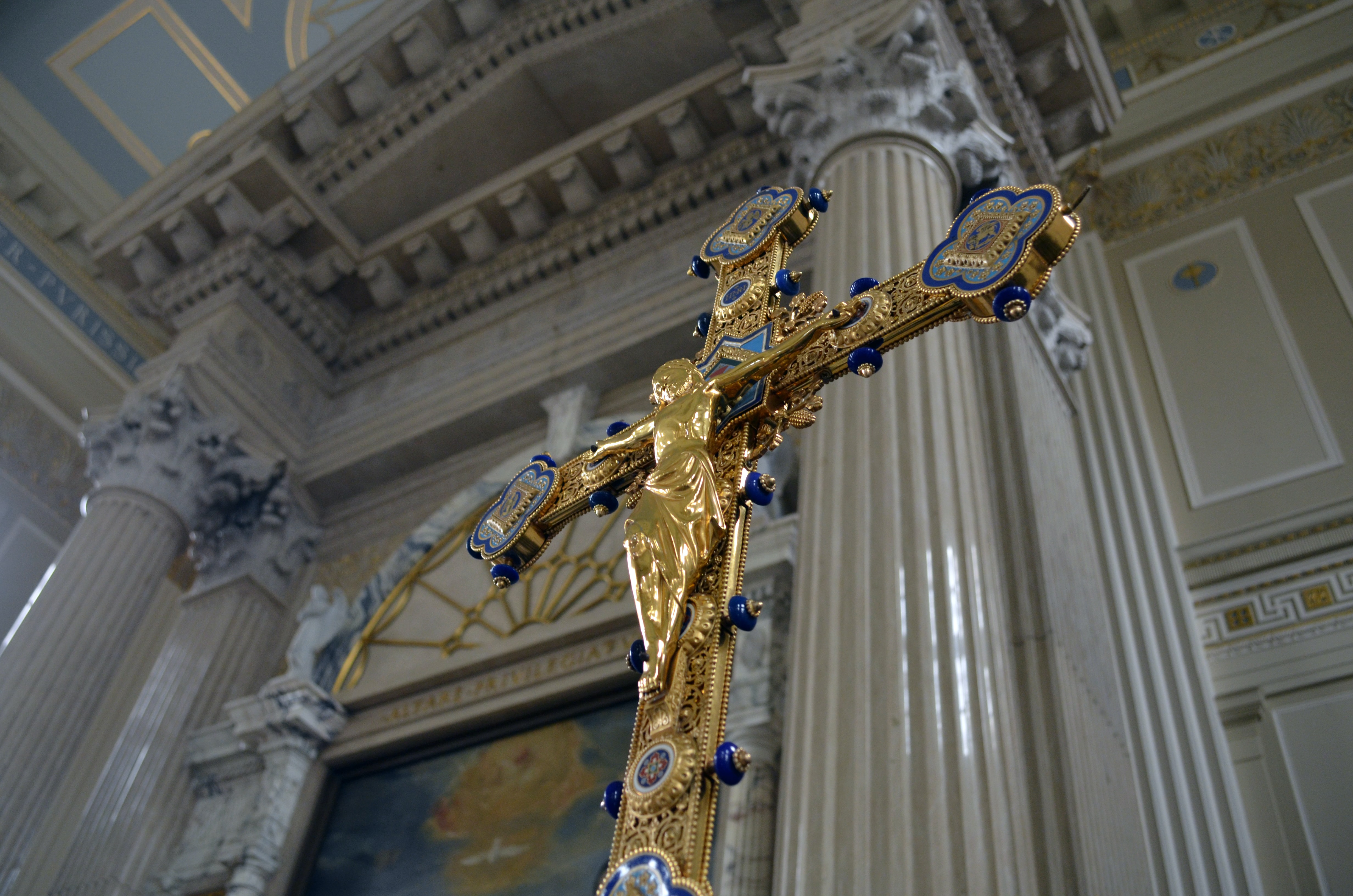“We adore Thee, O Christ, and we bless Thee. Because, by Thy Holy Cross, Thou hast redeemed the world!”
—Antiphon from the Liturgy the Veneration of the Cross on Good Friday
Twenty-some years ago, proposing a lecture on the Holy Cross to a director of religious education at a parish in California’s San Fernando Valley, I touched on allusions to the Cross in the Old Testament. She stopped me: “My professor at Mount Saint Mary’s in West LA said Christians have no business imposing their imagery and beliefs into Hebrew Scripture.”
Either she misremembered what her professor taught, or the principle was taught poorly. Truly, Christians have no need to suppose that Isaiah, Malachi, Amos or any other prophet knew when or how God would fulfill their inspired oracles, let alone knowing anything about Jesus of Nazareth. And that wasn’t what I was suggesting.
Not wishing to contradict her directly, I chuckled pleasantly, “Well, Jesus described how Moses raised the serpent in the desert to prefigure His crucifixion, so I guess I’m in pretty good company.”
Alas, the good people of that parish were deprived of hearing my presentation.
In his Pentecost sermon (Acts 2:14-40), Simon Peter declared that the prophecy of Joel (3:15), “The sun shall be turned to darkness, and the moon to blood,” was fulfilled 52 days before, “as you yourselves know” (verse 22), when darkness at noon was joined to the blood moon known to astronomers as having risen over Jerusalem during the early evening of April 3, the day Jesus died.
Selecting several prophecies regarding resurrection composed by King David, notably Psalm 13:35, “You will not abandon My soul to the netherworld, nor will You suffer Your Holy One to see corruption,” the fisherman of Galilee, now a fisher of men, confidently cried out, “Therefore let the whole House of Israel be certain that God has made Him both Lord and Messiah, this Jesus whom you crucified” (Acts 2:36).
So, throughout 1,988 years, Catholics have searched the Hebrew Scriptures to find Jesus Christ in prophetic utterances, prototypical incidents, and images prefiguring Gospel events in order to exclaim, “Oh, that’s what it means!” Thus, Elisha’s multiplying bread portends Jesus multiplying loaves and fishes; both the Tree of Life in Eden and Isaac bearing on his shoulders the wood of his sacrifice, suggest the Cross, and so on.
St. Paul explains how the Cross, the instrument of ignominy, became the triumphant sign of God’s overwhelming love:
“He humbled Himself, becoming obedient unto death, even to death on3 a cross. For which God has both exalted Him and has given Him a name which is above all other names” (Philippians 2:8, 9);
“God forbid that I should boast, save in the Cross of our Lord Jesus Christ” (Galatians 6:14);
“God proves His love for us in that while we were still sinners Christ died for us … And not only this, but we also exult in God through our Lord Jesus Christ, through whom we have now received the reconciliation” (Romans 5:8, 11).
In like manner, reporting the discussion between Jesus and Nicodemus, St. John the Evangelist shows Jesus making a distinction in language.
In Numbers 21:9, the bronze serpent was “lifted up” — the Hebrew שׂוּם הַנֵּס literally meaning: “put it upon a pole.” In other words, Moses simply mounted the serpent on a piling so it could be seen from a distance.
St. John reports Jesus saying, “As Moses lifted up the serpent in the desert, so must the Son of Man be lifted up” (John 3:14). Our Lord contrasts His raising by employing the Greek word ὑψόω (hupsŏō), meaning: “to exalt, to raise to dignity, honor and happiness,” showing “that everyone who believes in Him may have life everlasting” (verse 15).
While Wisdom 16:10 states, “Not even the fangs of poisonous serpents overcame your children, for Your mercy came forth and healed them,” during the last week of His earthly life Jesus jubilantly proclaimed, “Now is the prince of this world cast out. And I, if I be lifted up from the earth, shall draw all things to Myself” (John 12:31, 32).
Gazing on the bronze serpent, Israelites who looked upon it were saved from the fiery bites of seraph serpents in the wilderness. Gazing with love upon Jesus crucified, the faithful can be saved from the fiery bite of the Ancient Serpent, the Devil.
# # #
“The Cross is at the center of history” is a well-known adage reflected in the feast of the Exaltation of the Holy Cross (Sept. 14), on which Christians joyfully exult Our Savior and consider the triumphant exaltation of the Cross. Nevertheless, the liturgical celebration of the Holy Cross has a complicated history.
In 326, the recently converted Empress Helena, mother of the Emperor Constantine, journeyed to Israel. She wanted to verify the historical nature of the Gospels by certifying places associated with the life and ministry of Jesus. Eusebius, the Church historian of the mid-300s, relates that Helena, although in her 70s, “was fired by youthful vigor.”
The original celebration of the Discovery of the Holy Cross was assigned to May 3, the date on which three crosses were found buried in an old cistern. St. Cyril, bishop of Jerusalem (350-386), wrote that, relying on God’s power, a dying woman was brought to Calvary. She touched each cross. With the last she was cured. St. Macarius, Jerusalem’s bishop in 326, thereby declared it the True Cross.
St. Ambrose of Milan and St. John Chrysostom of Constantinople, contemporary with St. Cyril, know a less dramatic tale. Those two bishops claimed the True Cross was recognized because the titulus, the death warrant in three languages written on a board by Pontius Pilate, was still attached to it.
Constantine caused two new churches to be built on the sites of the Crucifixion and Resurrection. At one end of a great courtyard stood the massive basilica, the Martyrium on Calvary; at the other end a great rotunda, the Anastasis, surrounded the tomb of Christ. A chapel devoted to the Holy Cross stood next to the rock of Calvary.
On Sept. 13, 335, the Martyrium was consecrated. The relic of the True Cross, in a special silver reliquary, solemnly carried into the church on the 14th, was raised on high to receive the veneration of the faithful. An annual liturgical remembrance was composed for Sept. 14.
Persian Shah Khosrau II conquered Jerusalem in 614 during the Byzantine–Sasanian War of 602-628. The large portion of the Cross was stolen along with the half of the titulus left in Jerusalem by St. Helena.
In 629, Byzantine emperor Heraclius recovered the Cross from the Persians, placing it over the altar in the rebuilt church in Jerusalem on Sept. 14. This event caused the feast of the Exaltation of the Holy and Life-Giving Cross to take on greater solemnity in the Eastern Church. A few years later, violent forces within the recently emerged Islamic religion prompted Heraclius to bring the portion of the Holy Cross in its reliquary to Constantinople, where history loses sight of it.
The Latin Church also celebrated both the Discovery of the Holy Cross on May 3 and the Exaltation of the Cross on Sept. 14.
In 1955, Venerable Pope Pius XII made May 1 the Feast of St. Joseph the Worker as a Catholic response to the May Day parades of atheistic Communism, and Pope St. John XXIII abolished the May 3 feast of the Discovery of the Cross so the ancient feast of the Apostles Sts. Philip and James, displaced by Pius, could have a new home.
“We should glory in the cross of our Lord Jesus Christ, for he is our salvation, our life and our resurrection: through him we are saved and made free.” –The entrance antiphon for the Feast of the Exaltation of the Holy Cross
Sean M. Wright, MA, an Emmy-nominated television writer, is a Master Catechist in the Archdiocese of Los Angeles and an instructor for his parish’s RCIA team. He answers comments sent him at [email protected].










